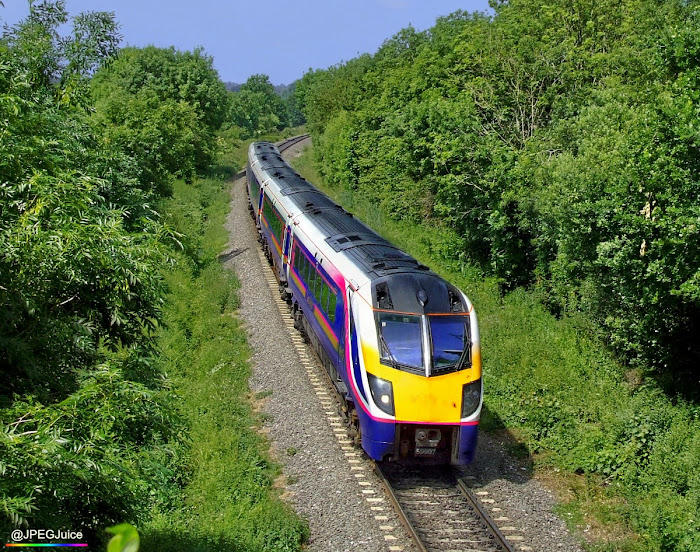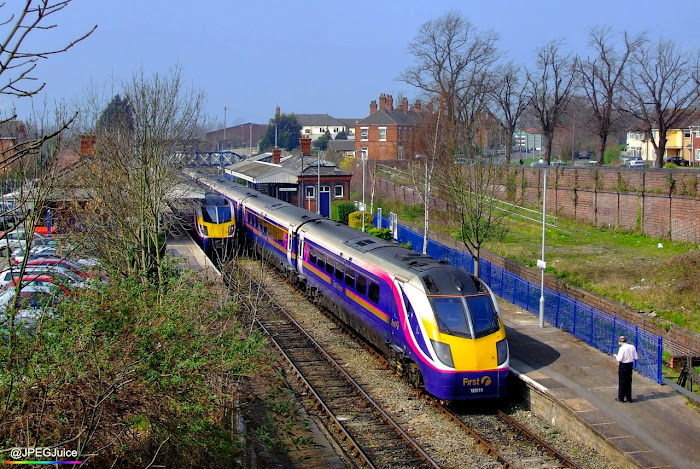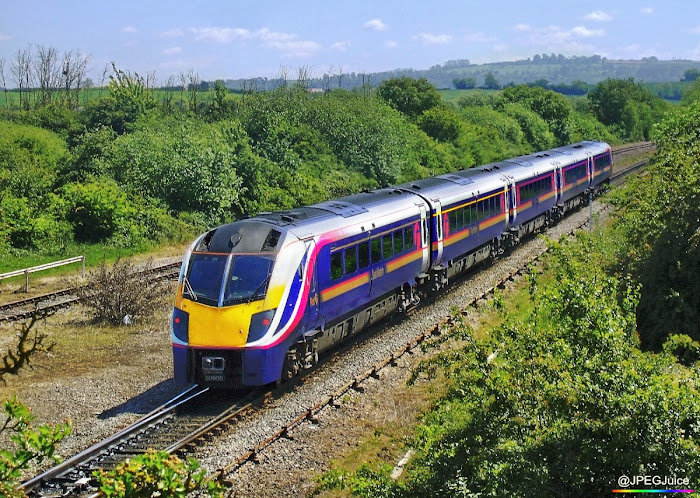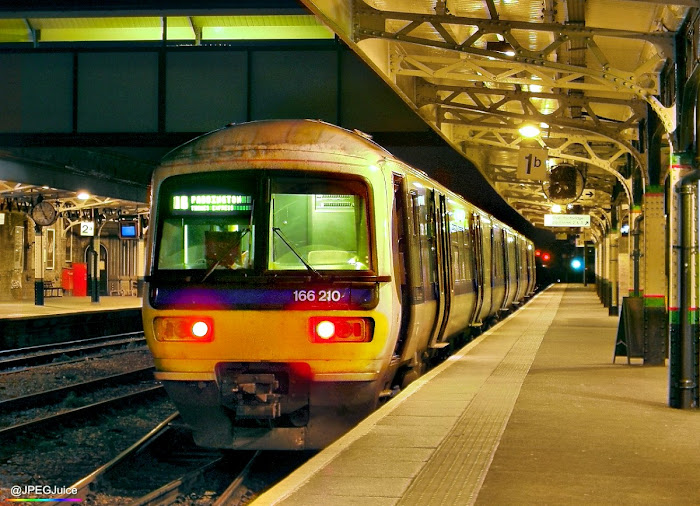"Developed and prototyped without Automatic Train Protection, the 180s were held back while the safety system's fitting was organised, and other safety considerations were dealt with."

If you thought the Virgin Voyager was the first true 125mph DMU to hit UK rails... Well, as regards actual service, you'd be right. But if you count testing, the Voyager was beaten to it by Alstom's Class 180 unit, which began its long regime of trials at Old Dalby in April 2000.
Whilst the Voyager drifted into service with Virgin bang on time in May 2001, the 180 suffered heavy delays and did not in the end begin service with First Great Western until the end of 2001. Even then, only one unit was available, and the second did not enter traffic until March 2002. By which time the Voyager had stolen all the glory.

Great Western's order for fourteen diesel-hydraulic Class 180s came about in a bid to ease the strain on their HST fleet. And like Virgin, Great Western initially considered a plan to use Class 67s for at least part of their renewal. But both operators eventually settled on wall-to-wall DMUs, not least because of the higher access charges that would be run up by Class 67 locomotives.

The Class 180's earliest setbacks were knock-on effects from the Southall and Ladbroke Grove disasters of the late 1990s. Especially for Great Western - whose trains were involved in both crashes - a spotlight fell not only onto crash-prevention features, but also onto how a high speed DMU (i.e 125mph with no separate locomotive or DVT) would minimise harm to front-carriage passengers in the event of an actual collision.

On the Paddington to Worcester line between 2004 and late 2007, the Adelantes were pretty jealous occupants of the territory. 180111 meets 180109 at Evesham on 28th March 2007.
Developed and prototyped without Automatic Train Protection (ATP), the 180s were held back while the safety system's fitting was organised, and other safety considerations were dealt with. The primary sticking point over the course of the 180's production and introduction delay was safety.
It may seem crazy today that a major Great Western order was planned without ATP in the wake of the 1997 Southall crash. But it was widely accepted that the Southall accident would have been prevented had the Great Western HST's existing AWS been active, and it wasn't until after the late 1999 crash at Ladbroke Grove that press and public pressure mounted for ATP installation. By that time, the Class 180 order was already well advanced. And since there were hints that ATP may soon be enshrined into legislation, First saw little choice but to order its fitting to the 180s.

Despite serving as the initial test train, pioneer Adelante 180101 was not the first to enter service.
The intro timetable looked to be in recovery on 19th December 2000, when 180101, running with a small, stick-on set number, began the type's main line testing programme. Initially, these were not full speed tests. In fact, the set did not run at 100mph until 7th January 2001, but testing continued through the winter, with no reports of drastic problems.

Three's a crowd, but it's a photogenic crowd in this instance, as Adelante 180107 lines up with Centro/Central Trains 150014 and Wessex 158871 at Shrub Hill station in summer 2005.
Later in the winter of 2001, First Great Western confidently came up with the reference “Adelante” for their 'Barbie' liveried paragon of aerodynamics. The unit was a fine sight, and with its new Spanish name (which had multiple applicable meanings), it was ready to glam up the Western Region. Alstom just needed to get the rest of the fleet built. Easier said than done...

In fact, the process dragged its heels so much that by autumn 2001 there were rumours that First had ditched its Adelante order, and opted to buy a fleet of Voyagers instead. First strenuously denied the rumours, but admitted they were not happy about the delays to delivery. That was probably a very considerable understatement, given the smooth introduction of the Voyager, which was now scaling up widely over the CrossCountry timetable... With not a single 180 yet passed for service use.
A Passenger Safety Case Panel meeting on 13th December 2001 finally turned the key in the door for passenger service, but only 180104 was approved, and that would remain the situation well into the following year.

The first booked services for the Class 180 were the 11:15 Paddington - Bristol and 13:04 Bristol - Reading, which used the same unit - initially just 180104 - Monday to Friday. 180105 also became available to share the duty from 18th March 2002. From June, the original diagram was abandoned, and two new ones were implemented, linking Paddington with Cheltenham, Cardiff and Bristol. As more units went into traffic in the course of the summer, the booked workings were scaled up, but all of the usage remained between Paddington and Cheltenham, or Bristol, or South Wales.

How the Worcester - Paddington services looked in the hands of Thames Trains, before the Class 180s took over. This is 166210 waiting to depart Worcester for Paddington at Christmas 2003.
At this time in summer 2002, services between Paddington and Worcestershire - the location for all of the photos in this post - were predominantly run by Thames, with 'Turbo' units. First Great Western did, however, punctuate the timetable using HSTs. This situation persisted until 2004, when FGW adopted the former Thames services and commenced employing Class 180s on the Paddington - Worcester route. The Adelantes then became a primary mainstay on the “Old Worse & Worse” until late 2007, when refurbished HST sets took over the Cotswold duties.

In 2008, the three remnant Adelantes worked in conjunction with the refurbished HSTs on the Cotswold line, and could be seen together at Shrub Hill. In this shot, taken on 14th March 2008, 180104 has been de-branded - a clear sign that the story which began nearly eight years earlier had not gone to plan.
Going into 2008, the FGW Adelante units - plagued with technical issues over the course of their lives to date - were mostly placed into store. Three were held active, and were focused on selected duties between Paddington, Oxford, Worcester and Hereford before First Great Western dumped the last of them entirely in March 2009.
The type did subsequently find its way back to the Western Region, but would surely be best remembered in its original 'Barbie' livery, during the relatively short period between its very late eventual introduction and its ignominious return to the leasing company in the late 2000s.

The far better respected HSTs arrived in refurbished form to the relieve the Adelantes of their duties. But were the HSTs as photogenic in this guise, as the 180s had been in their 'Barbie' livery?
